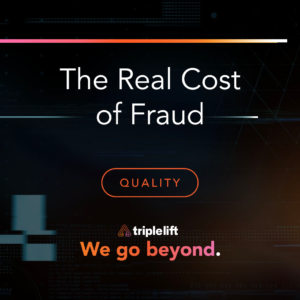The Real Cost of Fraud and Low Quality Environments

In today’s ad ecosystem even the biggest brands and most premium publishers can fall victim to fraud and low quality inventory. TripleLift’s Max Dowaliby, Senior Director of Product, joined us to offer a deeper look at how TripleLift is helping buyers and publishers to protect their brand, budget and business.
There’s been a good deal of discussion about programmatic ad fraud lately, but you’ve said that fraud is part of a larger set of problems that TripleLift is solving.
That’s right. We think about ad quality from a number of angles, and fraud is obviously a very important part of that. But so is understanding where ad dollars are going, knowing that the publishers that you’re working with are legitimate, and making sure the ad is viewable.
Let’s touch on all those issues, but starting with fraud specifically.
When people say “ad fraud,” they generally mean invalid traffic from bots. It’s really important to an advertiser that their ads are in front of human eyes. With human eyes, you get actions, like clicks for purchases, or signing up for an account. If those ads are being shown to fake people, there’s zero chance that those fake people can take the action the advertiser wants.
What steps has TripleLift taken to combat invalid traffic?
Our goal is to ensure that our buyers and our partners never have the opportunity to buy a single impression that can be identified as fraud.
We’ve built a deep relationship with WhiteOps. We were one of their first supply side partners. Every ad is pre-scanned by WhiteOps for fraud before brands have an opportunity to bid on it. If WhiteOps tells us that they believe that an ad opportunity stems from a bad actor, we don’t hold an auction.
How do you deal with publishers that might feature hate speech? That’s a huge concern for advertisers.
We’ve taken a hard stance that we won’t monetize content that is identified as misinformation or malicious content. Last year we began partnering with NewsGuard, an organization that uses trained journalists to rate the quality of news and information sites, all by hand. Their trust ratings help us to monitor publishers for misinformation, hate speech and calls to violence. Anytime a publisher appears on their list, if we work with that publisher, we drop them.
Can you give a sense of how many sites you had to drop?
After we measured our impression volumes, it turned out that we never had a significant problem to begin with. We started to think, why was that the case? It boils down to the fact that we have direct relationships with all of our publishers. We can pick up the phone and call every single one of them.
So those direct relationships are very helpful from a buyer perspective.
Our direct relationships with publishers are important to advertisers in two ways. The first is an efficiency gain — you’re not paying a margin twice or even three times in some cases. The second is that you avoid uncertainty of the ad experience. Without directness, you don’t know where some piece of inventory originates, which can introduce brand safety and some of the other issues we’re discussing.
Since we’re talking about buyer concerns, let’s touch on how TripleLift deals with viewability.
We work with all of the industry leading partners here. MOAT is a huge partner of ours. We are compatible with every viewability vendor and ensure that none of the inventory on our platform falls below a certain threshold. We don’t want to hold auctions for inventory that have a very low likelihood of ever being viewed.
We’ve touched on social responsibility and the ad ecosystem. Is there anything you want to add about that?
The programmatic ecosystem in general has a responsibility to understand that it directs a lot of money, and where these ad dollars go has a dramatic impact on a lot of things. It’s unfortunate that sometimes only the brand gets blowback for where their ads end up, but not those who are monetizing the malicious content – there are multiple parties here (ourselves included) who should be held responsible.
At TripleLift, we want to make sure we are not funding entities that promote misinformation, hate speech, or calls to violence. We also want to protect our brand partners; no brand wants to see their ad next to hate speech.
But with the policies we’ve discussed at TripleLift, just choosing the right SSP can solve so many issues for brands.
Brands should know what inventory they’re buying, and some inventory just shouldn’t be available for purchase. If you think about it, spending on malicious sites takes dollars away from genuinely good content on the internet. That’s part of why TripleLift has created initiatives to direct advertising dollars to good causes. For example, through our Exchange Traded Deals, curated inventory packages, buyers can help to advance equality by directing spend to minority-owned publishers. There is social capital in this, but there is also real money flowing between the advertisers and these publishers. And that good outcome happens because of programmatic advertising.
Thanks so much, Max!
Thank you.
See more on how TripleLift goes beyond to deliver scale, quality and service to ensure your campaign’s success.
The post The Real Cost of Fraud and Low Quality Environments appeared first on TripleLift.

